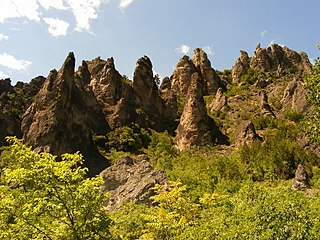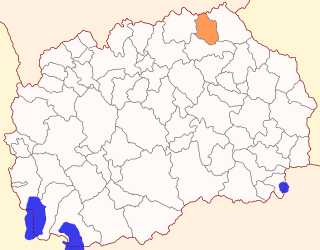
The provinces of Bulgaria are the first-level administrative subdivisions of the country.

Kyustendil Province is a province in southwestern Bulgaria, extending over an area of 3,084.3 km2 (1,190.9 sq mi), and with a population of 107,673. It borders the provinces of Sofia, Pernik, and Blagoevgrad; to the west, its limits coincide with the state borders between Bulgaria and North Macedonia, and between Bulgaria and the Republic of Serbia. The administrative center of the Province is Kyustendil.

Kumanovo is a city in North Macedonia and the seat of Kumanovo Municipality, the largest municipality in the country. Kumanovo lies 340 metres above sea level and is surrounded by the Karadag part of Skopska Crna Gora mountain on its western side, Gradištanska mountain on its southern side, and Mangovica and German mountain on the Eastern side. Skopje airport also serves Kumanovo.

European route E 75 is part of the International E-road network, which is a series of main roads in Europe.
Karposh's rebellion or Karposh's uprising was a Christian anti-Ottoman uprising in the Central Balkans that took place in October 1689 during the Great Turkish War of 1683-1699. Karposh - the nickname probably derives from the Bulgarian or Macedonian word карпа - the leader of the rebellion, was born in the Sanjak of Üsküp in the then Rumelia Eyalet of the Ottoman Empire, probably in the village of Vojnik, and named Petar. At a very young age, he escaped to Wallachia, where he worked as a miner. Later, Karposh moved to the Rhodope Mountains, where he settled in the Dospat valley, becoming a notorious hajduk. After the army of the Holy Roman Empire advanced into the Ottoman Balkans, Karposh moved to the area of Znepole, and began to organise anti-Ottoman resistance-detachments there.

Kyustendil is a town in the far west of Bulgaria, the capital of the Kyustendil Province, a former bishopric and present Latin Catholic titular see.
Bulgarian placename etymology is characterized by the linguistic and ethnic diversity of the Balkans through the ages and the position of the country in the centre of the region. While typical Bulgarian placenames of Slavic origin vastly dominate, toponyms which stem from Iranian, Turkic, Arabic, Hebrew, Celtic, Gothic, Greek, Thracian and Latin can also be encountered.

Rankovce is a municipality in the northeastern region of the Republic of North Macedonia. Rankovce is also the name of the town where the municipal seat is found. Rankovce Municipality is part of the Northeastern statistical region.

Iliya Markov, known as Ilyo Voyvoda or Dedo Iljo Maleshevski, was a Bulgarian revolutionary from the region of Macedonia, who is considered a national hero in both Bulgaria and North Macedonia. He was the father-in-law of revolutionary Dimitar Popgeorgiev (1840-1907).

Shopi or Šopi is a regional term, used by a group of people in the Balkans. The areas traditionally inhabited by the Shopi or Šopi is called Shopluk or Šopluk (Шоплук), a mesoregion. Most of the region is located in Western Bulgaria, with smaller parts in Eastern Serbia and Eastern North Macedonia, where the borders of the three countries meet.

The Serbs are one of the constitutional ethnic groups of North Macedonia, numbering about 24,000 inhabitants.

Zemen is a town in Pernik Province, western Bulgaria. Located near the Pchelina Reservoir on the banks of the Struma River, it is the administrative centre of Zemen Municipality.

Orah or Suvi Orah is a village in North Macedonia administrative located in the Staro Nagoričane municipality near town Kumanovo in the micro-region of Sredorek. It used to be part of the former municipality of Klečevce.

The Corridor VIII is one of the Pan-European corridors. It comprises both road and rail routes. Both commence on the Italian Adriatic coast at Bari or Brindisi, with a ferry crossing to Durrës in Albania. From there the routes cross the southern Balkans into Bulgaria and thence to Varna, on the Bulgarian Black Sea coast. The road corridor follows the route: Tirana/Durrës/Vlorë – Elbasan – Skopje – Pernik – Sofia – Plovdiv – Burgas – Varna. Although as yet incomplete, it is broadly paralleled by the rail route: Durrës/Vlorë-Lin-Radožda-Kičevo-Skopje-Kumanovo-Beljakovtse-Kriva Palanka-Gyueševo-Sofija-Burgas-Varna.

National Road I-6 is a major road in Southern Bulgaria. It runs from Gyueshevo at the border with North Macedonia and Burgas on the Black Sea coast. With a total length of 508.5 km (316.0 mi), I-6 road is the longest road in Bulgaria.

Sofia City Province is a province (oblast) of Bulgaria. Its administrative center is the city of Sofia, the capital of the country.
The Stolichna Municipality is an obshtina (municipality) in Sofia City Province, Western Bulgaria. It is named after its administrative centre, the city of Sofia, which is also the capital of Sofia City Province and Sofia Province and the capital of Bulgaria as well.

The Battle of Sofia was the culmination of Russian General Iosif Gurko's Western Squad for the defeat of the Orhaniye army in the Russo-Turkish War (1877–1878). It led to the Liberation of Sofia from Turkish rule.

Pirin Macedonia or Bulgarian Macedonia is the third-biggest part of the geographical region of Macedonia, today in southwestern Bulgaria. This region coincides with the borders of the Blagoevgrad Province, as well as the surrounding area of Barakovo from the Kyustendil Province. After World War I, Strumica and the surrounding area were broken away from the region and were ceded to Yugoslavia.

Severna Makedonia is a book by Yordan Ivanov, a Bulgarian literary historian, archaeologist and folklorist, and contains historical research for the history of the Kyustendil region from antiquity to the Liberation of Bulgaria (1878). The book was published in Sofia in 1906. It consists of 12 chapters. Chapter 1 is about the ancient Pautalia and its surroundings, Chapter 2 is to medieval Velbuzhd. Chapter 3 examines the development of Christianity in North Macedonia. Chapter 4 traces the emergence, history and fall of the Ottoman Empire in the area. Chapter 5, entitled "Kyustendil Sandjak", provides a geographical and historical overview of the cities located in this area: Dupnitsa, Radomir, Vranje, Kriva Palanka, Kratovo, Shtip, Veles, Radovish, Strumitsa, Kochani and Kumanovo. Chapter 6 deals with agriculture and mining in the district. Chapter 7 researches the history of Kyustendil in the 19th century. Chapters 8 and 9 are dedicated to the Kyustendil Diocese in the 19th century. Chapter 10 contains information on the 19th-century schools in Shtip, Kratovo, Kyustendil, etc. Chapter 11 provides information on the ancient and medieval epigraphic monuments. Chapter 12 contains references to the corresponding preceding pages. The book contains 420 pages, with 3 maps, 21 graphics and 18 black and white photo illustrations, a plan, 5 facsimiles and 65 epigraphic monuments from Latin, Greek, Slavic and Ottoman sources and a pointer of personal and geographical names. It has long been a bibliographic rarity.



















